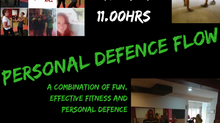Being in Flow
- Renegade Martial Arts

- Nov 9, 2020
- 3 min read
"Don't get set into one form, adapt it and build your own, and let it grow, be like water."
Bruce Lee
"Life is a series of natural and spontaneous changes. Don't resist them; that only creates sorrow. Let reality be reality. Let things flow naturally forward in whatever way they like."
Lao Tzu, Tae Teh Ching

The ability to move and flow with circumstances underpins efficiency. In life, as well as specifically in martial arts, being in a state of flow with your opponent (here meaning circumstances or experience rather than merely an physical adversary) is essential to successful personal development and growth. Flow for our purposes is centred on the principle of effective and efficient movement from one position (or technique) to another. Through the understanding and adoption of this principle it is possible to effectively form a combination of techniques, where in one naturally 'fits' with and essentially creates the next. In addition to most efficiently applying our technique we must 'fit' with and flow with the movement of our opponent.

In modern psychology the term 'flow state' has been coined to describe a focused mindset where the individual is fully immersed in a given activity, feeling a sense of positive enjoyment and fulfillment. Whilst accepting these qualities are important, in application to Renegade Taekwon-do flow is a much wider reaching concept. The essence of flow is not a reduction of focus but stems from a heightened awareness and sensitivity to the experience. In this way we are able to adopt a position which does not seek to control or oppose the experience, rather through increased awareness and sensitivity we are able to better 'fit' ourselves within the situation, actively changing and adopting new behaviours in response to the changing nature of the experience. The principle of flow therefore further underpins a non-judgmental mindset where there is no prescribed 'correct' response or technique, there is merely what is appropriate in that moment. In true flow the selection of our response is simply determined by identification of that method which is the most efficient and purposeful available to us at that time. The individual circumstances of the experience determine the appropriate response, to predict an outcome or anticipate a fixed result can be a very limiting belief and restrict our ability to efficiently and naturally respond.

Physically it is possible to obtain an increased sense of flow by being fully aware of how a given movement or combination of movements feels. By maintaining an intrinsic awareness, sensitivity and understanding of our biomechanics, weight distribution and balance we are able to best identify where and how we can move. This sense goes beyond the mere repetition of techniques, it is based on the identification of how we are positioned at that moment with our opponent, the opportunities presented and the most efficient means of exploiting these.
Whilst technical rehearsal and a solid foundation in the fundamental techniques are essential, the principle of flow necessitates that we must seek to exist beyond the simple approach of, "If my opponent does this, then I do that." In flow there is no determined response, there is simply what exists at that moment and our ability to move in a way that most effectively communicates (physically or verbally) given the unique nature of that opportunity.
There will naturally be those techniques which form sequences which 'fit' together (for example those that transfer from lead to rear such as a jab - cross) and it is important that through training we recognise and provide opportunity to train and develop our capabilities with these. However flow is not limited to these. The principle of flow does not rest within any single set of techniques or training method. Rather the principle of flow exists at the very centre of all technical development and training methods.

















































Comments